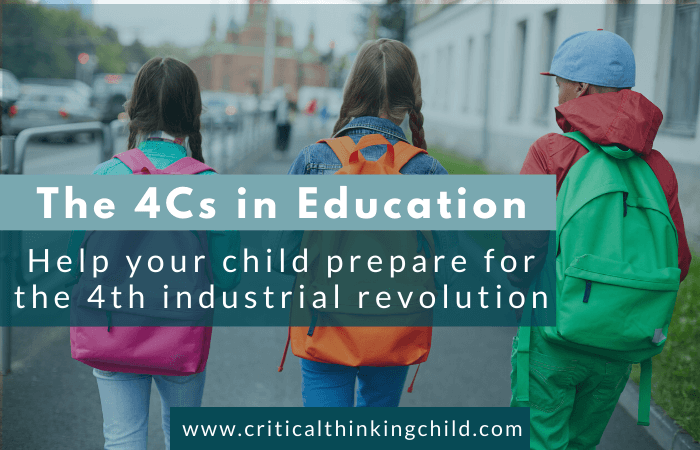When you hear the phrase “industrial revolution” you probably think of the first Industrial Revolution, which took place in the late 1700s and early 1800s and marked the shift from farming and agriculture to machines and new ways of manufacturing. However, here in the United States we’re actually in the midst of our fourth industrial revolution!
Each new industrial revolution marks a major shift in how people live, work, play, and — most importantly — learn. As the tools and resources around us change, so does the way we interact with the world and learn to operate within it. As a parent, that means the tools of the past may not show up in the same way now.
Luckily, there are plenty of ways to help your child thrive in this latest industrial revolution — and today we’re digging into four of them.
A look back at the first three industrial revolutions
Before we look at where we are now, let’s take a look at past shifts the U.S. has experienced. Each one has led us closer to where we are today, and created a profound impact on how we interact as a society.
The first industrial revolution began in the late 1700s and went through the early 1800s. The invention of the steam engine allowed goods to be manufactured and sold on a much larger scale. This led many people to move away from farming and into manufacturing jobs.
The second industrial revolution took place in the late 1800s and early 1900s and was spurred on by the invention of electricity. This allowed for production lines and the shipment of goods across country lines. It also led to longer work days, since people were no longer limited by the sun.
The third industrial revolution started in the 1950s. It centered upon the increasing use of computers, transistors, and digital systems.
What is the fourth industrial revolution?
The World Economic Forum calls the fourth industrial revolution one of “cyber-physical systems,” which basically means the integration of technology with our bodies, jobs, and lives.
This revolution is different from the third one in the 1950s, when computers were first being explored. Back then, this sort of digital technology was seen as a way to improve industry. For decades, this mindset has stuck around. Typewriters, radios, and desktop computers evolved and became faster and more reliable, but they remained tools.
The fourth industrial revolution, on the other hand, takes technology to a new level. Instead of being seen as a tool, technology has become an integral part of who we are. It’s integrated seamlessly into our healthcare, our entertainment, our work, and our education.
In addition, this fourth industrial revolution is marked by the speed at which technology is being developed and utilized. In the past it might have taken years, or even decades, for a new breakthrough. These days, they’re happening all the time.
Why does this matter for your family?
With the fourth industrial revolution comes revolutionized workplaces and classrooms that rely heavily on communication, collaboration, and problem-solving. In addition to learning how to navigate technology effectively, young learners must cultivate strong critical thinking skills that are adapted to the modern age.
While many schools have programs and resources in place to prepare students for this “new-collar” workforce, it’s your responsibility as a parent to reinforce these lessons. It all starts by helping your young learner master the 4Cs of the Common Core standards: critical thinking, communication, collaboration, and creativity.
The 4Cs: What you need to know
Each of the 4Cs tackles an important, foundational area of learning and thriving in today’s technologically-savvy world. The good news is that it’s easy to practice these skills at home with your child. Here’s how:
Critical Thinking Skills
Critical thinking encompasses a number of skills: effective reasoning, systematic thinking, problem solving, analytical learning, and the ability to make effective judgments and decisions. Since our world is changing so fast, students and workers need to solve problems quickly and make decisions at a moment’s notice. The earlier you can start developing these skills at home, the better.
You can improve critical thinking skills at home in lots of fun ways:
- Pose tricky but fun “would you rather” questions, like “Would you rather sound like a bird or look like a bird?” and have your child reason through their answer.
- Ask your child to review books, movies, and TV shows, explaining what they would do differently and why.
- Involve your children in solving real-world problems at home, like what to put on the grocery list or how to respond to a double-booked schedule.
- Work with your child to develop step-by-step instructions for common household activities, like making a sandwich, cleaning up toys, or setting the table.
Communication Skills
Communication skills go beyond talking to others. To develop strong communication skills, your child will need to listen to others and articulate their ideas both verbally, nonverbally, and in writing. With the increase in technology of the fourth industrial revolution, communication is at our fingertips and your child will be required to be “on” more often than not, so effective communication skills are even more important.
The key to getting kids excited about communication is to make it relevant to their lives. Ideas to implement at home include:
- Have them write emails or letters to a good friend, telling them about a recent family outing.
- Ask them to deliver a speech explaining why your family should get a new pet.
- Suggest keeping a vacation journal on family trips, where your children can write about the things they do and see.
- Play games with your child where two toys get into a disagreement and have your child explain the point of view of each toy.
- Pose a hypothetical situation where your child is faced with a cyber bully. Ask them how they would communicate this situation to others*.
*Note: Cyber bullying is a real threat that’s only on the rise. If you want to help your child learn how to be safe and secure in a digital world, consider checking out the all-new Cyber City book series.
Collaboration Skills
The ability to work well with others, not just friends and familiar peers, is more vital than ever. Collaboration is so important in today’s modern workplace; workers are increasingly required to work well with people in both in-person and virtual environments, taking on an appropriate role in a group, and neither taking up too much space nor too little.
Collaboration skills come naturally for some kids, but for others it will take some practice. Having a clearly defined role at first will help your child take the appropriate amount of responsibility, and you can ease up on this structure once you think your child can handle it.
Here are some ways to practice at home:
- Give your child a “role” within a recurring group, like a family book club. You could assign your child be the questioner or the timekeeper.
- Work on a project as a family, like putting up birthday decorations or putting in a new garden. Assign your child to paint the decorations or choose the seeds.
- Ask your child to think about which roles they’re naturally “best” at, and which ones they feel like they might need help with, and to explain why.
Creativity Skills
Innovative ideas are what makes the fourth industrial revolution so fast-moving and exciting. Your child is living at the forefront of a world that’s changing every single day, and it’s fueled by creativity. This means not only coming up with your own creative ideas, but also working creatively with others and implementing innovation. This out of the box thinking will be essential to the modern workplace, where employees need to develop new solutions to new problems.
Creativity is a fun skill to work on at home and you can tweak it to include pretty much any interest your child may have. This is where you can let your child’s imagination run wild!
Here are some ideas to get started:
- Encourage your child to write their own play around a topic they love.
- Ask them to create a new invention that solves a problem they see.
- Pose a mundane household problem (like folding laundry) and see if your child can find a creative way to tackle the chore.
Take it slow and enjoy the journey!
The fourth industrial revolution may sound overwhelming, but you can start small. Choose one of the 4Cs and pick one strategy to implement. Then, enjoy the journey with your child—you never know how they’ll end up surprising you with their new skills and ideas!
Sources:
https://www.digitalpulse.pwc.com.au/fourth-industrial-revolution-guide/
http://www.nea.org/assets/docs/A-Guide-to-Four-Cs.pdf
https://www.sentryo.net/the-4-industrial-revolutions/



